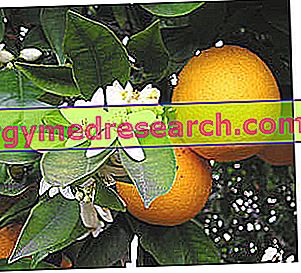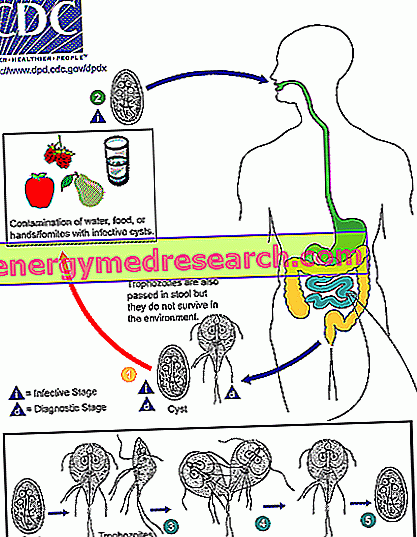Properties and uses of the orange
In addition to lemon, grapefruit and mandarin, orange is certainly one of the most appreciated and appreciated citrus fruits by young and old. Excellent natural remedy against stages of inappetence, the orange is a real vitamin bomb, very useful not only for its antioxidant power, but also to stimulate brain activity, promote digestion, relieve stomach pains, purify the body and ensure a calming effect, at the expense of anxiety and stress.

The orange, moreover, for its fruits with a round shape and bright color, has been the object of numerous artistic works, while the white flowers are sung and exalted by many poets and writers.
Also in the kitchen, the orange is a very popular citrus fruit, which goes well with meat and fish dishes, as well as enriching fruit salads and decorating aperitifs and soft drinks.
Generality
The sweet orange is assured the primacy of the most consumed and widespread citrus in the world: in this regard, hundreds of different varieties are cultivated. Italy ranks 5th in the ranking of the major orange producers (according to FAOSTAT statistics, 2005), producing over 2.5 million tons per year; Brazil has earned first place, with production estimated at around 18 million.
The sweet orange is native to China but, in all probability, it was already known at the time of the Ancient Romans in the first century AD. It was introduced in the Iberian Peninsula only in the 1300s. It is said that the Arabs brought oranges to Sicilian territory in the far 9th century AD: in Sicily, the orange was called melarancia, while in literature it assumed the appellative of portugal until 1800.
However, the nicknames attributed to the orange are very numerous: purtualli (in Sicilian), portuguese (in the dialect of Ferrara), partaall (in Abruzzo), partaall (in Liguria), naransa (in Veneto), purtiall (in the Gargano), portacallu (in Salento) etc.
Botanical description
Orange ( Citrus aurantium subsp . Dulce ) is a cultivated tree belonging to the Rutaceae family: the leaves, fleshy, elongated, shiny and dark green, embellish the branches, embellished with beautiful white flowers, perfumed, with 5 petals. The fruits are roundish esperidi, consisting of exocarp (flavedo) from the fully ripe orange color, mesocarp (albedo) white and spongy with a bitter note. The edible part is the endocarp, succulent and fleshy, subdivided into 8-12 segments containing few seeds.
The sweet variant differs from the bitter orange for the absence of green cauline thorns, for the sweet taste and for the leaves without winged petiole. [taken from Ragionese Dictionary of herbal medicine and phytotherapy, by A. Bruni and M. Nicoletti]
Variety
Given the enormous market demand for oranges, many varieties are grown in Italy. However, oranges are generally divided into two supercategories, blondes and reds, differentiated on the basis of the color of the pulp. In addition to these, we find the "squeezed oranges", with a thinner but extremely juicy and very sweet peel, and "table oranges", larger, with a fleshy skin, generally less juicy, but just as tasty and sweet.
Among the "blond" oranges we remind the navelina, washington navel, ovale, etc., while among the reds it is a must to mention the Rossa Sicilia, including the varieties mora, sanguinello and tarocco : the latter take on a typical red color in the pulp thanks to the presence of some anthocyanins not included in the blonde variety.
Orange: nutritional properties
Oranges provide only 34 Kcal per 100 grams, therefore they are indicated in dietary regimes that require few calories. Per 100 grams of orange (edible part) there are 87 grams of water, about 8 grams of carbohydrates, 1.6 of fiber, 0.7 of protein and very little fat (0.2 g).
These citrus fruits are appreciated for their ascorbic acid content, although the estimated intake of vitamin C in kiwis, peppers, spinach and strawberries is far superior.
The essential oil (or essence of Portugal ) obtained from leaves and orange peel is very rich in limonene, monoterpene constituting 80% or 90% of the whole essence. In the essential oil there are also aldehydes, linalool, geranial, coumarins, furocumarines and black.
The essence of neroli is very well known but, unlike what you might think, sweet orange does not represent its starting matrix: neroli extract is obtained exclusively from bitter orange flowers.
Other chemical components include citroflavonoids, carotenoids, flavanones (narirutin and hesperidin), anthocyanins (cyanidin-3-glucoside, typical of red oranges), hydroxycinnamic acids (ferulic, coumarin, caffeic) and fatty oils.
Therapeutic uses
In general, the orange is used in herbal medicine for the antispasmodic and stomachic virtues: therefore, it is used above all in states of loss of appetite. Let us now try to investigate further therapeutic actions associated with orange.

The richness in vitamin C ensures a powerful antiscorbutic activity, antiradical, as well as enhancing the body's immune defenses. The usual consumption of oranges favors digestion thanks to the substances that can stimulate the gastric juices and relieve any pain in the stomach.
The dried LEAVES are used as a mild sedative, diuretic and stomachic. In higher doses, the decoction of dried leaves of sweet orange is a good natural remedy to counter cough (convulsive type) and spasms.
Dried FLOWERS, on the other hand, are used in the treatment of mild insomnia.
Recently experimental studies have been carried out on small guinea pigs (rodents) to test the potential effect of the orange on uricemia (parameter expressing the amount of uric acid in the blood) and uricosuria: after a period of administration equal to three weeks, it was observed " A reduction in uricemia due to hepatorenal uricolysis with uricosuria without changes in diuresis" . [taken from the Dictionary of herbal medicine and medicinal plants, by Enrica Campanini]
ESSENCE extracted from orange is also used by the perfume industry, for the realization of perfumed waters, shampoos, shower gel, body milks and perfumed creams. In the food sector, the essence of sweet orange is used for the preparation of liqueurs and spirits, as well as to make jams and fruit jellies.
The furocumarine present are photosensitizing pigments, therefore they are sometimes used in the formulation of products to treat skin diseases.
In cosmetics, the sweet orange extract is used in the formulation of anti-aging, depigmenting and after-sun lotions.
The orange and its properties, in short »



